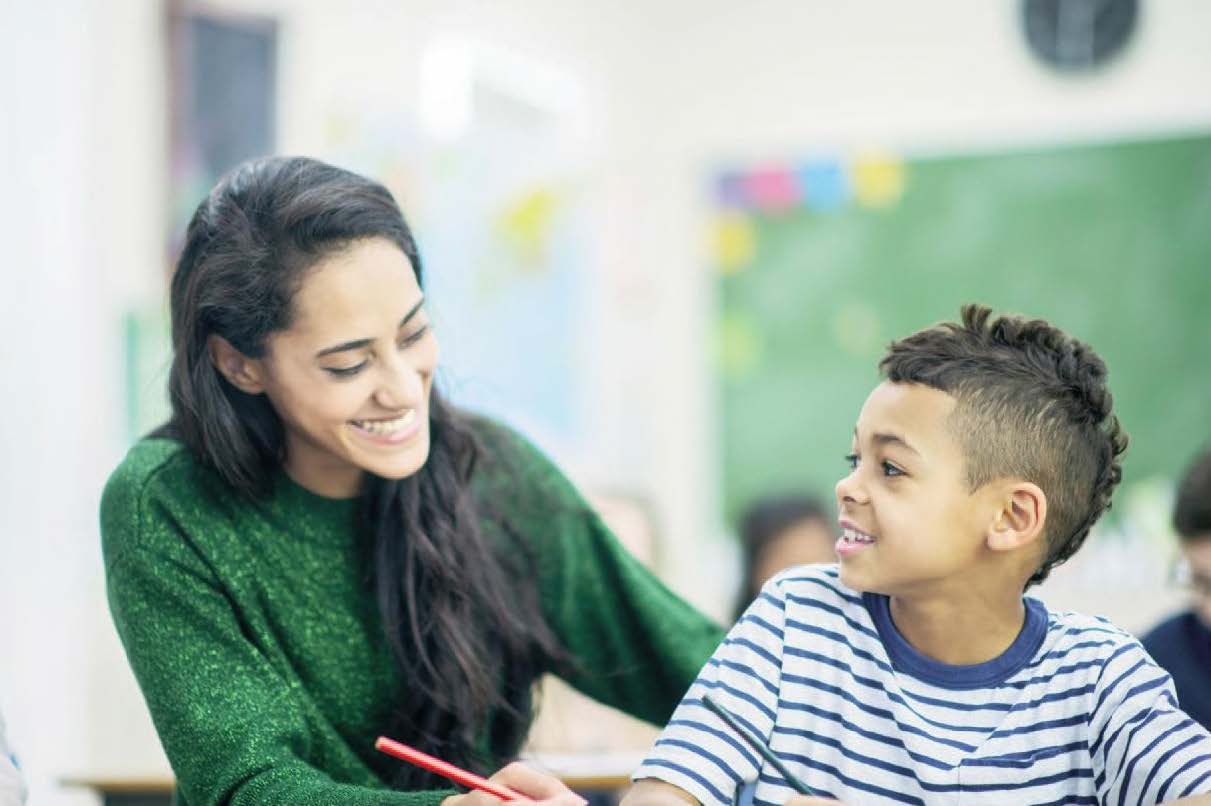
BUILDING BRIDGES BETWEEN SPECIAL EDUCATION & GENERAL EDUCATION THROUGH AN UNDERSTANDING OF SPECIALIZED VISUAL SUPPORTS
BY ANGELA SHAW
As the winds of change affect the processes and strategies of education, the purpose in educating young minds must be broadened to include meaningful learning for a variety of students. Under such principles instituted within the Individuals with Disabilities Education Act (IDEA) and Common Core State Standards (CCSS), teachers and administrators are provided a roadmap to build upon.
At the same time, it takes human skill, insight, and vision to provide our students with an infrastructure that delivers and ensures engaged learning. Visual strategies have enhanced the communication process for many people throughout civilization. Historians, archeologists, and sociologists construct meaning of earlier societies or cultural norms, based upon a wide array of visual artifacts from a time long ago. Visual supports are found all around and can help increase a learner's understanding and independence as they navigate their environments.
Today, visual aids and strategies can be seen in the form of street signs and traffic lights to organize travel goals. Everyday visual supports, including calendars, to-do lists and organizational apps, keep us on track, and move us through our day-to-day obligations. For example, universal symbols found on our car dash may alert us to when our tire pressure is too low. Symbols in food packaging warn us about allergens that may be lurking in what we are about to eat. Within our communities, we can navigate faster as we scan for icons that lead us to elevators, fire exits, or public restrooms.
The specialized visual supports that are used by students in the classroom enhance communication in support of access and understanding within their learning community, as well as increase independence. Visual scaffolds lend a forward perspective that is more focused, as students become more skilled at utilizing tools of engagement.
IDEA calls for supplementary aids and supports to be considered and implemented for students within their Individualized Education Program (IEP), based upon appropriateness to the students' needs. The supplementary aids and supports themselves are ever-evolving and flexible. As the students' paths become individualized to their particular learning profile and experience, aspects of the support may be adjusted. Scaffolded learning through accommodations are customized tools and/or strategies built into a student's IEP to support appropriate advancement toward attainment of goals, including progress in the general curriculum. Visual supports are one avenue to support the journey, but they often intertwine and navigate across other modalities of support to include sensorial effects of kinesthetic movement/touch and auditory aspects relative to listening and making sense of language.
When creating a plan that's individualized for a student's need, team members set forth to combine their areas of expertise in determining the most appropriate course of action within the continuum of supplementary supports needed to scaffold access to learning within the least restrictive environment (LRE). An occupational therapist may provide input to a need for visual or kinesthetic supports with specialized paper, which will support a student providing written expression that is legible or organized. The speech/language pathologist may provide insight to the need for gestures or picture-prompting, in support of understanding information received receptively or conveyed expressively.
Implementation of a student's IEP is incumbent upon the team members' understanding of each student's needs, strengths, and interests. Therefore, the IEP team, including parents, teachers, and related service providers, as well as student (as appropriate), must work together to ensure supplementary aids and services are appropriate to the need. Discussion centered around the needs of the student in relation to curriculum, school routines, homework, and so on, provide the opportunity to explore options that ensure appropriate supports which are individualized for the student. Through collaborative- and solution-based discussion, team members work together to gain perspective of the student's present levels and synthesize a range of tools necessary to encourage and build student resilience and understanding leading to the accomplishment of learning targets.
Achieving routine, structure, and sequence through visual supports brings to light a more concrete approach to abstract concepts. Visual scaffolds provide opportunities for increased student focus and may help decrease anxiety. Students are assisted through visual tools with transitions, communication, and expectation. Although special education and related services are based upon the identified need of the student, rather than the category of the disability listed on the student's IEP, there are often characteristic overlaps relative to needs or challenges within disability categories. The IEP team may need to consider these in anticipation of scaffolds of supports. For example, a student identified with autism spectrum disorder (ASD) is often supported through their visual learning channel, much as students identified with attention deficit disorder (ADD), emotional disturbance (ED), other specific learning disabilities (SLD), or speech/language impairment (SLI). Further, since no two learners are alike, students within the general education classification may make their learning connections through visual strategies and tools, to include students with English Language Learner (ELL) needs. Scaffolds in support of social/emotional and academic aspects cover a wide array of student needs with a goal of decreased frustration, anxiety or anger and increased independence, engagement, and understanding to include:
- ✓Understanding rules
- ✓Communication of the receptive and expressive nature with others
- ✓Provision of organization
- ✓Transitional support from one task or event to the next
- ✓Provision of clarity relative to expectation of task or behavior
- ✓Opportunities to receive positive feedback
LAUNCHPAD OF VISUAL SCAFFOLDING IDEAS
Visual supports have the ability to teach and support social and academic skills, as well increase the ability to process information. Visual scaffolds have been shown to be successful for all students, to include students with and without a disability. Below is a table presenting examples of supports that may be provided to support students toward increased understanding and independence.
Behavior often delivers communicative intent. Visual communication can support student expression. Choice boards and help cards are examples of visual communication tools that serve to scaffold appropriate behavior.
The simple choices presented on this morning greeting schedule that special education teacher Carrine Bell provides for her students allows them to choose how they will say good morning as they enter their classroom each day. Choice icons represent: a hug, a high-five, or a dance step. This simple scaffold serves to set the day off on a positive and productive note.

Providing physical scaffolds that are consistent and clear, supports all students (and teachers) with the day-to-day business of classroom procedures and access. Scaffolds can be as simple as providing a marked bin for turning in finished work and parking things such as small toys, snacks, or other non-academic items.
These bins are used within a pullout special education program. Preteaching about the use and etiquette of the boxes is essential. Students know that their treasures are safe when placing them in the "stuff" bin because it is a policy and rule that only the owner of the item be allowed to touch those things. Additionally, color-coding the cards supports students who are not yet fluent readers.

A visual boundary in to assist a student in understanding expectations, such as where their body needs to stay during circle time. This serves to support a student with sensory regulation difficulties from entering the space of others. Other students are reminded to respect and provide ample space to the student who may exhibit the sensorial need of having their own space. Tools in support of setting physical boundaries may include carpet squares or specialty cushion available from school or O.T. supply shops, which make it easy when customizing a physical space for a student with this need. The addition of these visual and kinesthetic supports provide access to peers and increased inclusion within the learning environment.
A seat cushion can make a comfy statement when setting the boundaries in support of students' physical support. Pattie Overduin, a licensed/registered occupational therapist who provides partnership and O.T. services at the school level through CAHelp/DMSELPA, notes that supports such as these have the ability to increase student core strength and endurance. Overduin suggests that increased circle time relative to a student's need, with tools such as this are beneficial to improved stamina, strength, and focus.
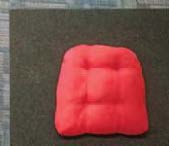
COMMONSENSE TIPS TO GUIDE IMPLEMENTATION OF VISUAL SUPPORTS
Accommodations noted within the IEP are essential elements in support of providing access to education and curriculum to children with disabilities in general education classes, as well as other learning-related settings. Within the IEP, a range of supports, supplementary aids, and services are listed to provide the framework for implementation across settings. When an educational team undertakes the design of a visual tool to meet the needs of a student with special needs, the end game is engagement and access in an increasingly independent manner within a decreasingly restrictive environment. To lead to proper implementation, clarity and growth, some commonsense suggestions are presented below to guide IEP teams in support of the core directive of visual scaffolds.
UNDERSTANDING
Be certain that the visual supports designed are understandable to all team members, to include student, teachers, related service providers, and parents. Mindfulness about what the scaffold is supporting and/or building is a critical component to meaningful implementation to include practice and usage of the tool and/or strategy. When listing a support within the IEP, a simple operational description of what to look for, or when to utilize the support — such as "May be provided opportunities to move (i.e.: pass out papers, materials, collect materials, assist teacher, etc.), when becoming restless or fidgety"— will provide for increased understanding and lead to fidelity of implementation. Additionally, adjustments to supports through the following elements will ensure practical application:
- ✓Build in consultation/collaboration time between service providers and teachers, in order to modify or customize supports in a meaningful way.
- ✓Communicate with parents as visual supports are developed and utilized, in order to provide opportunities to generalize successful classroom supports within the home.
- ✓Review the expected curriculum and/or text books, in order to weave in expected academic language, provide task analysis appropriate to the expected outcome, and adhere to the suggested learning sequence.
TECHNOLOGICAL PROFICIENCY
Ensure the probability of implementation and generalization of the scaffold through certainty of proficient use. Training and/or a broad overview at the appropriate access level provides for a firm launchpad toward consistent use and internalization of procedure. As with any new system, familiarization and practice with the tools and procedures leads to a productive rhythm.
- ✓ Explicitly teach the process to student, to ease use and encourage meaningful participation.
- ✓Collaborate with teachers, related service providers and parents, as tools are customized. Provide an overview of the procedure through a quick note or email and ask if a consult is needed.
- ✓Pop in for observation within the setting, in order to support fluidity and meaningfulness of application.
APPROACHABILITY
As systems are built and customized, ensure that the support is easily accessible to the student and learning environment. Avoid unnecessary visual clutter or overuse of other distracting sensorial expression to include auditory or kinesthetic stimuli.
- ✓Ask for feedback from teacher or related service provider, relative to practical use.
- ✓Observe student and ask for his/her feedback.
- ✓Adjust tool, if needed, based upon verbal or observational feedback.
Customized cue cards, written or glued onto a 3x5 index card, can serve to support a student with working memory, planning, or receptive language challenges navigate procedures. Oftentimes, teachers use the same verbal prompts each year in guiding student procedures. In addition to direct instruction, co-operative learning ventures, and extra practice in a small group, a simplified version summing up the procedure will be a welcome support for students as they work toward building working memory and independence. Keep a few cue cards and teacher-created task or flow charts within a folder on your computer's desk top. This will allow you to print at will as you encounter students who may benefit from these structures.
This cue card is color-coded to further support understanding and essential practice. A reminder about using the number line is embedded. Consistent practice with this tool, along with near-point access to the number line, strives for entrance to working memory and eventual independence.
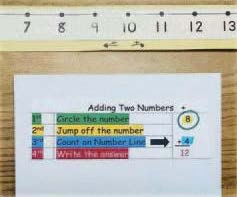
Visual schedules can be built to the varying needs across a range of students, as well as the varying needs of an individual student. Post schedules of the entire class displaying recess, lunch, and learning segments.
The mini visual schedule illustrated above provides an additional resource to scaffold the broader direction of "computer time". Through provision of teacher-presented choices, students with planning and attention challenges, as well as those with needs relative to emotionality, are provided a structured system.
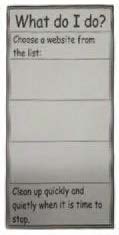
Task closure cards can support students in understanding expectations, such as where to start, what comes next, and when he/she is done. Once again, students who are challenged with working memory, planning or receptive language difficulties can be provided task closure cards to support navigation of multi-step procedures such as solve and color math worksheets. Removing barriers of confusion provides for a path of understanding and allows students to more fully participate in learning activities and decrease anxiety. Keep a digital version and customize it, as needed.
This task closure card is in support of a typical solve-and-color math worksheet. Barriers to access are removed and allow the student to learn and practice their math concepts in an engaging manner alongside their peers.
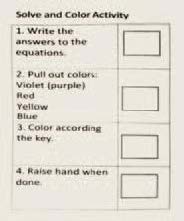
Task closure systems and visual scaffolds can be customized within the assignment. With today's digital tools, teachers and other educational support providers have the ability to tailor curriculum that meets the needs of students who require a little bit more in terms of focused engagement, in order to provide more practice and deeper understanding, in turn, leading to increased independence and decreased anxiety.
Building in the instructions in the form of a visual schedule, supports students with planning and working memory challenges, as well as those with emotional indicators. Provision of a set of explicitly-illustrated steps in support of showing work, clarifies expectation.
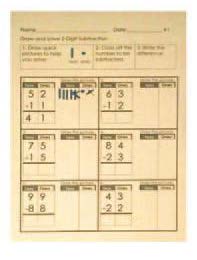
Graphic organizers customized to a student's need, provide visual cues in support of organization and planning. In the digital age, this allows teachers to design streamlined visual products that focus upon strategic areas.
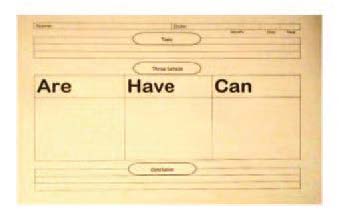
This tool can be used to support brainstorming activities or to create the framework of a written report. Visual organization tools such as this one help increase independence.
The ABCs of visual supports relative to common goals and outcomes begin with key elements designed to provide support of:
• Access: Learning modalities and strengths can support students at their customized point of entry. Students who are strong visual learners and/or demonstrate challenges with auditory learning, benefit from information presented at a more concrete representational format, in order to absorb and make sense of the communication, within their individualized ranges. For example, if a student is unable to read, has receptive or expressive language challenges, or is learning a new language, he or she may not be able to understand a schedule or graphic organizers that exclusively uses written words. A student in one of these situations may increase understanding through a schedule that uses pictures in order to scaffold the understanding. Such a scaffold would be individualized to the student's area of need and customize to his/her level of comprehension.
• Behavior: Supporting students who present with challenging behavior or emotional regulation is often an area addressed through visual scaffolds. Such visual/behavioral supports are beneficial in helping students regulate and calm themselves when agitated or anxious during times of transition, to sustain attention. The supports also provide information about expectations, as well as possible outcomes or consequences. Representation utilizing choices through visual closure or visual pacing systems afford benefit for a student with social/emotional components that spike behavioral actions. Decrease of anxiety or frustration by providing a visual to allow a student to see what needs to be accomplished before a break is earned, or in anticipation of a transition. Breaking lessons or assessments into manageable chunks can help increase attention and engagement and lead to increased compliance in task completion. Further, increased movement breaks can be built into a visual pacing or closure schedule, in order to provide the input needed by some students to maintain attention and engagement. Communication cards can provide a student with a visual system of communicative intent or expression through pictures, single words, or short phrases.
• Communication: Providing visual opportunities to receive communication and provide response or expression is essential to academic and social learning. Visual supports that provide structured choice as tasks are approached or completed, can encourage motivation and increase academic and behavioral success. Through visual scaffolds, educators and parents can design flexibly so that tasks can be completed at the student's approximated success level.
Educators providing academic and social scaffolds are not called to reinvent the wheel, but to repurpose, redesign or refine tools to meet a student's need or utilize a student's strength. This, in turn, provides a useful framework for the student to gain meaningful access or productivity within the constructs of their learning environment. As the IEP team deepens their understanding of visual tools and strategies, they will be able to guide and support students in their use and generalization. As educators sharpen their skills in choosing appropriate visual supports in their classroom, achievement and independence for all will blossom. A launchpad of ideas for your design in support of visual scaffolds to address areas relative to procedure, presentation, and social-emotional are the outcome of collaborative conversations between all IEP team members (educational caregivers from parent, general educators, administrators, related services providers and special educators) in support of student access, behavior, and communication.
CONNECTING TO DEEPER UNDERSTANDING THROUGH THE WEB
The eight examples spotlighted within the "Launchpad of Visual Scaffolding Ideas" guide are the outcome of collaborative connections and energies, experiences and research gathered through the years. There are many resources available to support and guide your team in discovering new and efficient methods to visually scaffold student learning. Below are a couple of helpful resources to provide for your journey of discovery and enrich your toolkit.
AUTISM INTERNET MODULES Visual Supports HEAD START CENTER FOR INCLUSION autisminternetmodules.org
The Autism Internet Modules (AIM) are available at no cost and are designed to provide information and professional development for people who support, instruct, work with, or live with someone with autism. These easily-accessible modules are filled with information to support students on the autism spectrum and also provide phenomenal practice to support students who may benefit from the array of supports. The Visual Supports page provides an abundance of evidence-based practice across a continuum of environments. Module objectives listed are to provide for participants to (Smith, 2008):
- • Develop an understanding of what visual supports do for individuals with ASD in the home, school, community, and work setting. This tool can be used to support brainstorming activities or to create the framework of a written report. Visual organization tools such as this one help increase independence.
- • Increase their knowledge of the terminology used by professionals when working with visual supports.
- • Increase their knowledge regarding best-practice examples of visual supports for use in the home, school, community and work settings.
- • Develop a knowledge base of resources and references in the area of visual supports.
Smith, S. M. (2008). Visual supports: Online training module (Columbus: Ohio Center for Autism and Low Incidence). In Ohio Center for Autism and Low Incidence [OCALI]), Autism Internet Modules, autisminternetmodules.org. Columbus, OH: OCALI.
HEAD START CENTER FOR INCLUSION Classroom Visuals and Supports headstartinclusion.org
Funded by the Office of Head Start, the Head Start Center for Inclusion website provides a treasure trove of information relative to their twofold mission:
- • The success of inclusion depends on everyone realizing that it involves much more than children "just being there."
- • Inclusion refers to the full and active participation of young children with disabilities in everyday settings. The comprehensive range of resources available within the site, to include print and multimedia, supports the goal of this website to "increase the competence, confidence and effectiveness of personnel in Head Start programs to include children with disabilities." The website synthesizes current research in including children with disabilities and current research on professional development, in order to move into authentic everyday practice. Click on the Classroom Visuals and Supports page to discover a broad range of fantastic visual scaffolds for young children.